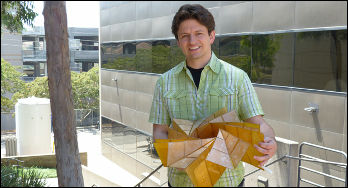"Origami" to space, research to apply origami technique to space panel is in progress

Now even in the world "OrigamiAs you can see from the fact that the name "Widely used" is widely used, origami derived from Japan attracts people all over the world. Although the eyes are deprived of the appearance that various solids are made from one sheet of paper, research that utilizes the mechanism to make it useful for space development is underway.
Solar Power, Origami-Style - NASA Jet Propulsion Laboratory
http://www.jpl.nasa.gov/news/news.php?release=2014-277
It is one of the laboratories belonging to NASA that is developing this methodJet Propulsion Laboratory(JPLMr. Brian Trees, a mechanical engineer at Jet Propulsion Laboratory. He has the experience of studying abroad in Japan when he was a high school student, he seemed deprived of the origami structure he saw for the first time, and he began studying various folding methods. About the fusing of this origami and the space panel Mr. Trees says "It is a crossover where art, culture, and technology intersect."

Mr. Trees is the Utah state of USABrigham Young University(BYU: Brigham Young University) in collaboration with the research team. You can see a glimpse of how the engineering using origami is being advanced with the following movie.
Origami in Space: BYU-designed solar arrays inspired by origami
A cylindrical object aligned on a desk. If you look carefully, it seems to have been assembled with folds in some places.

Working on a joint project with students and NASA is Larry Howell's professor of mechanical engineering at BYU. I am engaged in research to apply origami which is often regarded as a toy of children and girls from the viewpoint of engineering.

For example, if you pull up and down the regularly folded paper like this ...

Gradually wrinkle unravels ... ...

Finally it returns to a piece of flat paper with creases.

Although it seems to be a little different from what people imagine saying as "origami", it can be said that it is an excellent point of origami that it is possible to convert a flat material having a large surface area into a compact solid by folding it well That's right.

It's like an object with a pattern like a "braided tree" ... ...

Good luck and ......

This is originally a piece of flat paper.

When we spread the object at the center of everyone, we turned around the center and unwound, transformed into an amazingly large panel.

The above panel is a model of a space panel which is expected to be used for space antenna and the like in the future. It is actually 1/20 size, and ultimately we aim to compactly organize large panels with a diameter of 25 meters.
The operation image at that time is here. When the artificial satellite launched into space reaches a predetermined position ...

Panels that were folded around the satellite began to expand.

The panel expanded into a disk shape, but it will not end yet.

The panel that was visible on the plane is divided, and it continues expanding to a wider area.

And in the end the expansion was completed to one large panel. The feature of this panel seems to be that you do not need personnel to support movement when extending, and you can see the truss like frame being wrapped around the panel.

Applications as solar panels for generating energy of artificial satellites, as well as antennas used for communication with the ground and transmitters for transmitting power generated in space by microwaves to the ground are also conceivable I am doing.

Here is another model of origami panel.

The dice object changed to a square panel. The way to fold a plane is a scene that seems to be very profound.

BYU student Shannon Saabel advancing the project. This panel is a small satelliteCubeSat(Cube Sat), which is expected to be used in this case, we expect a power generation capacity of approximately 65 watts with this panel.

Also, Robert J. Lang, an American physicist and famous origami artist, is also involved in supervision of origami technology.

Mr. Lang's works can be seen from the following website. After going through the menu "Art" → "Compositions", you can touch a wide range of origami works, from living creatures to various objects.
Robert J. Lang Origami
http://www.langorigami.com/art/art.php

The biggest feature of the origami panel is that it is space-saving despite what it says, ironically it is possible to "fold the antenna small in a wide universe". It seems that some interesting research is progressing that origami, which has been popular since long time, is useful for space development.

Related Posts:







